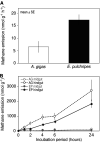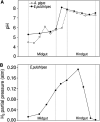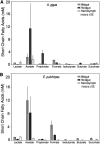Methanogenesis in the Digestive Tracts of the Tropical Millipedes Archispirostreptus gigas (Diplopoda, Spirostreptidae) and Epibolus pulchripes (Diplopoda, Pachybolidae)
- PMID: 34020937
- PMCID: PMC8276800
- DOI: 10.1128/AEM.00614-21
Methanogenesis in the Digestive Tracts of the Tropical Millipedes Archispirostreptus gigas (Diplopoda, Spirostreptidae) and Epibolus pulchripes (Diplopoda, Pachybolidae)
Abstract
Methanogens represent the final decomposition step in anaerobic degradation of organic matter, occurring in the digestive tracts of various invertebrates. However, factors determining their community structure and activity in distinct gut sections are still debated. In this study, we focused on the tropical millipede species Archispirostreptus gigas (Diplopoda, Spirostreptidae) and Epibolus pulchripes (Diplopoda, Pachybolidae), which release considerable amounts of methane. We aimed to characterize relationships between physicochemical parameters, methane production rates, and methanogen community structure in the two major gut sections, midgut and hindgut. Microsensor measurements revealed that both sections were strictly anoxic, with reducing conditions prevailing in both millipedes. Hydrogen concentration peaked in the anterior hindgut of E. pulchripes. In both species, the intestinal pH was significantly higher in the hindgut than in the midgut. An accumulation of acetate and formate in the gut indicated bacterial fermentation activities in the digestive tracts of both species. Phylogenetic analysis of 16S rRNA genes showed a prevalence of Methanobrevibacter spp. (Methanobacteriales), accompanied by a small fraction of so-far-unclassified "Methanomethylophilaceae" (Methanomassiliicoccales), in both species, which suggests that methanogenesis is mostly hydrogenotrophic. We conclude that anoxic conditions, negative redox potential, and bacterial production of hydrogen and formate promote gut colonization by methanogens. The higher activities of methanogens in the hindgut are explained by the higher pH of this compartment and their association with ciliates, which are restricted to this compartment and present an additional source of methanogenic substrates. IMPORTANCE Methane (CH4) is the second most important atmospheric greenhouse gas after CO2 and is believed to account for 17% of global warming. Methanogens are a diverse group of archaea and can be found in various anoxic habitats, including digestive tracts of plant-feeding animals. Termites, cockroaches, the larvae of scarab beetles, and millipedes are the only arthropods known to host methanogens and emit large amounts of methane. Millipedes are ranked as the third most important detritivores after termites and earthworms, and they are considered keystone species in many terrestrial ecosystems. Both methane-producing and non-methane-emitting species of millipedes have been observed, but what limits their methanogenic potential is not known. In the present study, we show that physicochemical gut conditions and the distribution of symbiotic ciliates are important factors determining CH4 emission in millipedes. We also found close similarities to other methane-emitting arthropods, which might be associated with their similar plant-feeding habits.
Keywords: Methanobrevibacter; Methanomassiliicoccales; digestive tract; methane; methanogenesis; methanogenic community; physicochemical parameters; tropical millipedes.
Figures






Similar articles
-
Methane production and methanogenic Archaea in the digestive tracts of millipedes (Diplopoda).PLoS One. 2014 Jul 16;9(7):e102659. doi: 10.1371/journal.pone.0102659. eCollection 2014. PLoS One. 2014. PMID: 25028969 Free PMC article.
-
Enzymatic activities in the digestive tract of spirostreptid and spirobolid millipedes (Diplopoda: Spirostreptida and Spirobolida).Comp Biochem Physiol B Biochem Mol Biol. 2020 Mar;241:110388. doi: 10.1016/j.cbpb.2019.110388. Epub 2019 Nov 18. Comp Biochem Physiol B Biochem Mol Biol. 2020. PMID: 31751767
-
Diversity and taxonomic revision of methanogens and other archaea in the intestinal tract of terrestrial arthropods.Front Microbiol. 2023 Nov 15;14:1281628. doi: 10.3389/fmicb.2023.1281628. eCollection 2023. Front Microbiol. 2023. PMID: 38033561 Free PMC article.
-
Methylotrophic methanogens everywhere - physiology and ecology of novel players in global methane cycling.Biochem Soc Trans. 2019 Dec 20;47(6):1895-1907. doi: 10.1042/BST20180565. Biochem Soc Trans. 2019. PMID: 31819955 Review.
-
Upflow anaerobic sludge blanket reactor--a review.Indian J Environ Health. 2001 Apr;43(2):1-82. Indian J Environ Health. 2001. PMID: 12397675 Review.
Cited by
-
Disruption of millipede-gut microbiota in E. pulchripes and G. connexa highlights the limited role of litter fermentation and the importance of litter-associated microbes for nutrition.Commun Biol. 2024 Sep 28;7(1):1204. doi: 10.1038/s42003-024-06821-2. Commun Biol. 2024. PMID: 39342029 Free PMC article.
-
Functional similarity, despite taxonomical divergence in the millipede gut microbiota, points to a common trophic strategy.Microbiome. 2024 Jan 29;12(1):16. doi: 10.1186/s40168-023-01731-7. Microbiome. 2024. PMID: 38287457 Free PMC article.
-
Some Aspects of the Physiology of the Nyctotherus velox, a Commensal Ciliated Protozoon Taken from the Hindgut of the Tropical Millipede Archispirostreptus gigas.Life (Basel). 2023 Apr 29;13(5):1110. doi: 10.3390/life13051110. Life (Basel). 2023. PMID: 37240755 Free PMC article.
-
De novo metatranscriptomic exploration of gene function in the millipede holobiont.Sci Rep. 2022 Sep 28;12(1):16173. doi: 10.1038/s41598-022-19565-y. Sci Rep. 2022. PMID: 36171216 Free PMC article.
-
The archaeome in metaorganism research, with a focus on marine models and their bacteria-archaea interactions.Front Microbiol. 2024 Feb 27;15:1347422. doi: 10.3389/fmicb.2024.1347422. eCollection 2024. Front Microbiol. 2024. PMID: 38476944 Free PMC article.
References
-
- Howarth RW, Santoro R, Ingraffea A. 2011. Methane and the greenhouse-gas footprint of natural gas from shale formations. Clim Change 106:679–690. 10.1007/s10584-011-0061-5. - DOI
-
- Smith P, Reay D, van Amstel A. 2010. Methane and climate change. Earthscan, London, United Kingdom.
-
- Strong K, Simpson WR, Bognar K, Lindenmaier R, Roche S. 2020. Trace gases in the Arctic atmosphere, p 153–207. In Kokhanovsky A, Tomasi C (ed), Physics and chemistry of the Arctic atmosphere. Springer Polar Sciences, Cham, Switzerland.
Publication types
MeSH terms
Substances
LinkOut - more resources
Full Text Sources
Other Literature Sources
Miscellaneous

